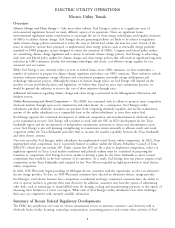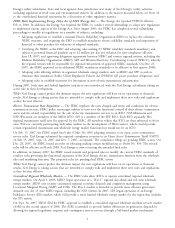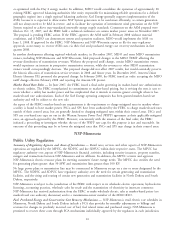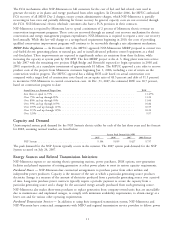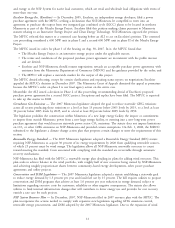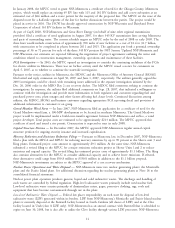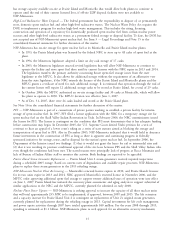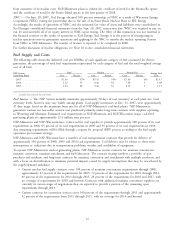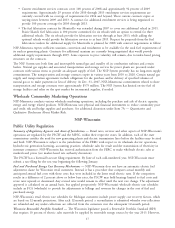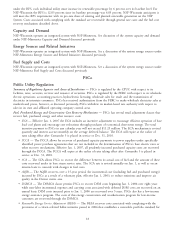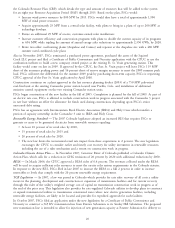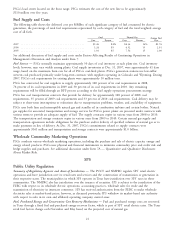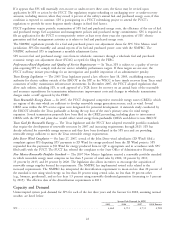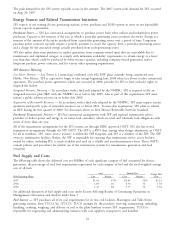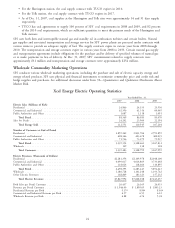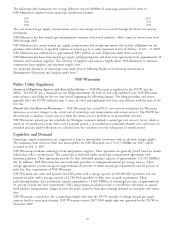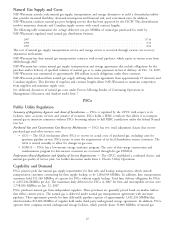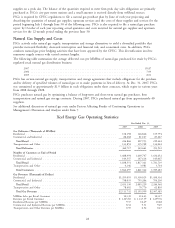Xcel Energy 2007 Annual Report Download - page 28
Download and view the complete annual report
Please find page 28 of the 2007 Xcel Energy annual report below. You can navigate through the pages in the report by either clicking on the pages listed below, or by using the keyword search tool below to find specific information within the annual report.under the RPS, each individual utility must increase its renewable percentage by 6 percent over its baseline level. For
NSP-Wisconsin the RPS is 12.85 percent since its baseline percentage was 6.85 percent. NSP-Wisconsin anticipates it
will meet the RPS requirements with its pro-rata share of existing and planned renewable generation on the NSP
System. Costs associated with complying with the standard are recoverable through general rate cases and the fuel cost
recovery mechanism described above.
Capacity and Demand
NSP-Wisconsin operates an integrated system with NSP-Minnesota. See discussion of the system capacity and demand
under NSP-Minnesota Capacity and Demand discussed previously.
Energy Sources and Related Initiatives
NSP-Wisconsin operates an integrated system with NSP-Minnesota. See a discussion of the system energy sources under
NSP-Minnesota Energy Sources and Related Initiatives discussed previously.
Fuel Supply and Costs
NSP-Wisconsin operates an integrated system with NSP-Minnesota. See a discussion of the system energy sources under
NSP-Minnesota Fuel Supply and Costs discussed previously.
PSCo
Public Utility Regulation
Summary of Regulatory Agencies and Areas of Jurisdiction — PSCo is regulated by the CPUC with respect to its
facilities, rates, accounts, services and issuance of securities. PSCo is regulated by the FERC with respect to its wholesale
electric operations, accounting practices, hydroelectric licensing, wholesale sales for resale and the transmission of
electricity in interstate commerce. PSCo has received authorization from the FERC to make wholesale electricity sales at
market-based prices, however, as discussed previously, PSCo withdrew its market-based rate authority with respect to
sales in its own and affiliated operating company control areas.
Fuel, Purchased Energy and Conservation Cost Recovery Mechanisms — PSCo has several retail adjustment clauses that
recover fuel, purchased energy and other resource costs:
•ECA — Effective Jan. 1, 2007 the ECA includes an incentive adjustment to encourage efficient operation of base
load coal plants and encourage cost reductions through purchases of economical short-term energy. The total
incentive payment to PSCo in any calendar year will not exceed $11.25 million. The ECA mechanism is revised
quarterly and interest accrues monthly on the average deferred balance. The ECA will expire at the earlier of
rates taking effect after Comanche 3 is placed in service or Dec. 31, 2010.
•PCCA — The PCCA allows for recovery of purchased capacity payments to power suppliers under specifically
identified power purchase agreements that are not included in the determination of PSCo’s base electric rates or
other recovery mechanisms. Effective Jan. 1, 2007, all prudently incurred purchased capacity costs are recovered
through the PCCA. The PCCA will expire at the earlier of rates taking effect after Comanche 3 is placed in
service or Dec. 31, 2010.
•SCA — The SCA allows PSCo to recover the difference between its actual cost of fuel and the amount of these
costs recovered under its base steam service rates. The SCA rate is revised annually on Jan. 1, as well as on an
interim basis to coincide with changes in fuel costs.
•AQIR — The AQIR recovers, over a 15-year period, the incremental cost (including fuel and purchased energy)
incurred by PSCo as a result of a voluntary plan, effective Jan. 1, 2003, to reduce emissions and improve air
quality in the Denver metro area.
•DSMCA — The DSMCA clause permits PSCo to recover DSM costs beginning Jan. 1, 2006 over eight years
while non-labor incremental expenses and carrying costs associated with deferred DSM costs are recovered on an
annual basis. DSM costs incurred prior to Jan. 1, 2006 are recovered over 5 years. PSCo also has a low-income
energy assistance program. The costs of this energy conservation and weatherization program for low-income
customers are recovered through the DSMCA.
•Renewable Energy Service Adjustment (RESA) — The RESA recovers costs associated with complying with the
provisions of a citizen referred ballot initiative passed in 2004 that establishes a renewable portfolio standard for
18


